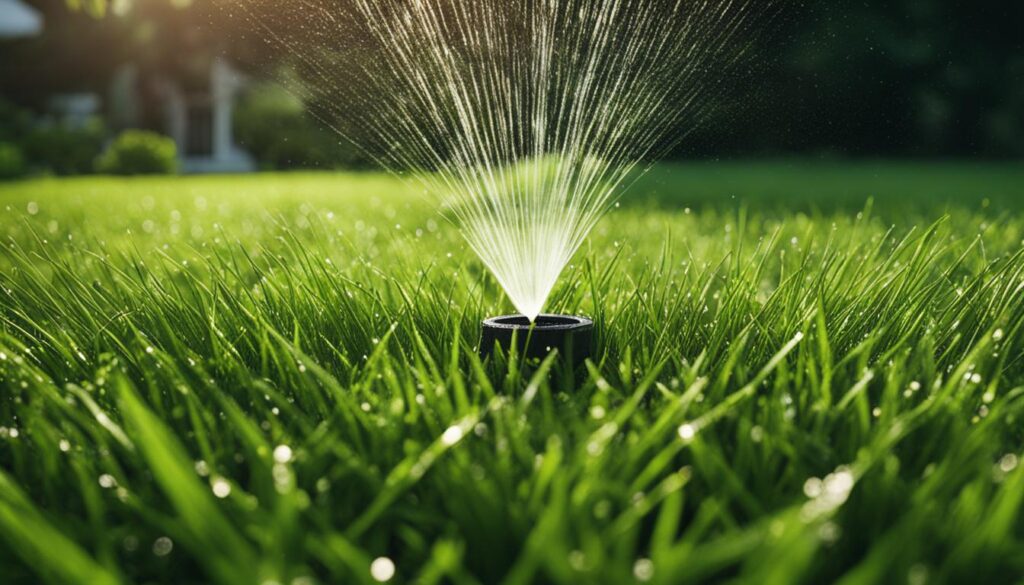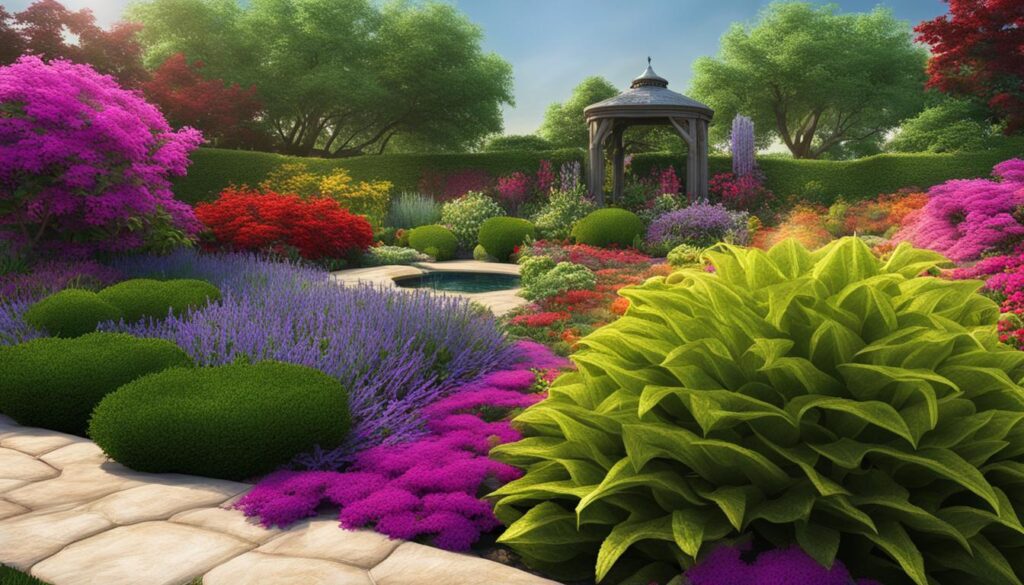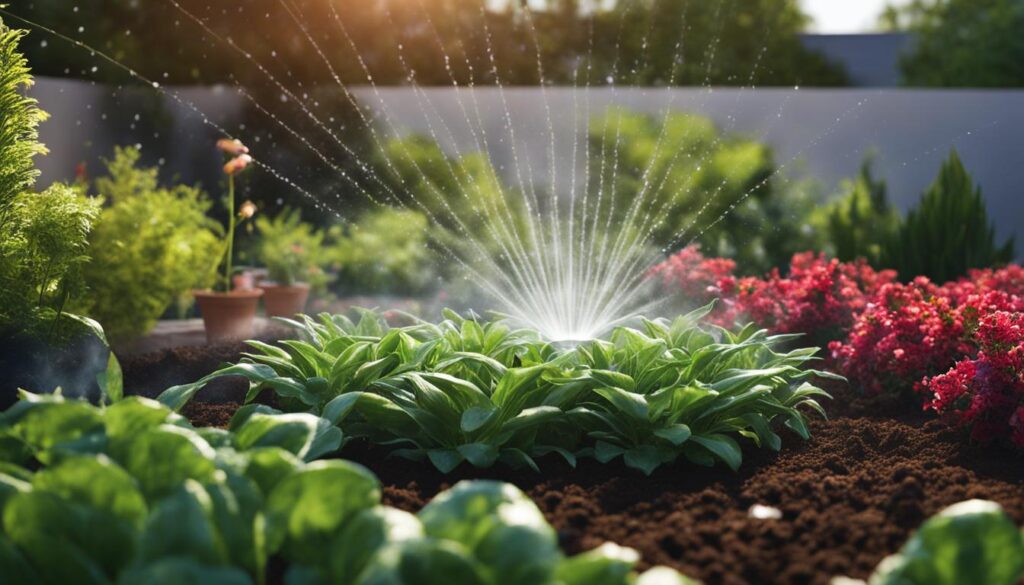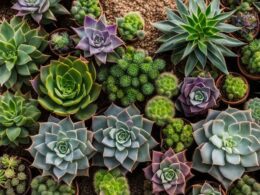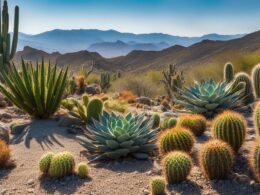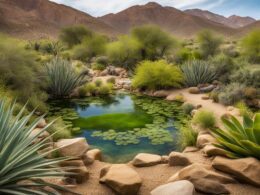Water is a valuable resource that needs to be conserved, especially in landscapes. In urban areas, up to 60% of water usage is allocated to maintaining landscapes, and a significant amount of it is wasted through inefficient use. To address this issue, landscapes should be designed to be as water efficient as possible. This can be achieved through various strategies such as good water conserving design, thorough soil analysis and preparation, limiting high water use plants, using low water use plants, implementing effective watering systems, incorporating mulch in flower and shrub beds, and following proper landscape management practices. By incorporating these principles, you can help preserve water resources while still creating beautiful and sustainable landscapes.
Key Takeaways:
- Use water conserving design techniques in landscape planning.
- Thoroughly analyze and prepare the soil for efficient water retention and drainage.
- Limit the use of high water-consuming plants and opt for low water use plants.
- Implement effective watering systems and techniques to minimize water waste.
- Incorporate mulch in flower and shrub beds to conserve moisture.
Start with a Water-Wise Plan
Creating a water-wise landscape is an excellent way to conserve water without sacrificing a functional and visually appealing outdoor space. To begin, sketch out the entire site and identify existing trees, shrubs, and grassy areas. Consider factors such as your landscape budget, desired appearance, maintenance requirements, and the water needs of different areas. Utilize local resources such as landscape architects and nurserymen for guidance in designing a water-wise plan that suits your specific needs.
Don’t forget to address any drainage problems and correct them in the initial planning stage. By creating planting beds with plants of equal water use and minimizing high water-use plantings, you can ensure that water is distributed efficiently throughout your landscape. Native plants are highly recommended as they have lower water demands and are more resistant to pests. Incorporating mulch in flower and shrub beds can help conserve moisture and reduce water evaporation, further contributing to water conservation efforts.
By starting with a water-wise plan, you can lay the foundation for a sustainable and water-efficient landscape that not only saves water but also maintains water quantity and quality for the long term.
Benefits of Starting with a Water-Wise Plan
- Conserves water by ensuring efficient water distribution throughout the landscape.
- Creates a visually appealing landscape that enhances the overall aesthetics of the property.
- Reduces maintenance requirements by selecting plants with similar water needs and minimizing high water-use plantings.
- Promotes the use of native plants, which are more adapted to the local climate and require less water and maintenance.
- Contributes to the preservation of water quantity and quality in the environment.
Turfgrass Selection and Watering Techniques
When it comes to creating a water-efficient landscape, one crucial aspect to consider is the selection of turfgrass. By choosing the right turfgrass variety and implementing efficient watering techniques, you can maintain a lush green lawn while conserving water.
Turfgrass Selection
Start by considering the intended use of the grassed areas in your landscape. Limit grassed areas to places that will have constant traffic, such as those used for cooking and eating or gaming. There are several turfgrass varieties suited for water-wise landscapes, including centipedegrass, bermudagrass, St. Augustinegrass, and Zoysiagrass. These grasses vary in their tolerance to drought conditions but generally require the same amount of water to remain green.
To conserve water, allow drought-tolerant grasses to go “off color” during dry periods and only irrigate when the entire lawn is dry. Water deeply and infrequently, applying one inch of water during each irrigation and allowing the turf to dry thoroughly between waterings. By selecting the right turfgrass and implementing efficient watering techniques, you can maintain a green lawn while conserving water and promoting a deep root system.
Efficient Watering Techniques
Efficient watering techniques are essential for conserving water in your landscape. In addition to deep and infrequent watering, consider the following:
- Water lawns in the early morning or late evening to minimize evaporation.
- Avoid watering on windy days to prevent water loss due to drift.
- Use sprinklers that distribute water evenly and minimize runoff.
- Consider installing a rain sensor or smart irrigation controller to adjust watering based on weather conditions.
By implementing these efficient watering techniques, you can reduce water waste and ensure that your turfgrass receives the necessary moisture for healthy growth.
Soil Preparation for Water Conservation
You can improve water retention and drainage in your landscape by properly preparing the soil. By incorporating organic matter and conducting soil testing, you can create an optimal environment for water conservation and healthy plant growth.
An essential step in soil preparation is adding organic matter, such as compost or decomposed leaves, to the soil. This organic matter improves the soil’s structure, allowing it to retain water more effectively. Additionally, organic matter enhances the soil’s ability to provide nutrients to plants, promoting healthy growth and reducing the need for excessive watering.
Before adding organic matter, it is important to conduct soil testing to assess its composition and properties. Soil testing provides valuable information about the soil’s pH level, nutrient content, and drainage capacity. Based on the test results, you can make informed decisions about the type and amount of organic matter to add, as well as any necessary amendments to optimize water retention.
Soil testing is an essential tool for understanding your soil’s characteristics and tailoring your soil preparation efforts for water conservation. By knowing the composition and properties of your soil, you can make informed decisions on organic matter additions and amendments to enhance water retention and drainage.
In addition to organic matter and soil testing, proper soil preparation for water conservation also involves improving drainage. Excess water can lead to root rot and other plant diseases, so ensuring proper drainage is crucial. This can be achieved by incorporating amendments such as perlite or vermiculite, which help create air pockets in the soil and improve its structure for better drainage.
By following these soil preparation techniques, you can create a landscape that maximizes water retention and drainage, leading to healthier plants and reduced water consumption.
Landscape Maintenance
Designing a water-wise landscape not only helps conserve water but also reduces the amount of maintenance needed to keep it healthy. By implementing proper maintenance practices, you can enjoy a beautiful and sustainable landscape while minimizing the time and effort required for upkeep. Here are some key strategies to reduce maintenance in your water-wise landscape:
Efficient Water Techniques
Using efficient water techniques can make a significant impact on reducing maintenance in your landscape. One approach is to install drip irrigation systems, which deliver water directly to the plant roots, minimizing water loss through evaporation and runoff. Drip irrigation also helps prevent weed growth by targeting water only to desired plantings. Another technique is to group plants with similar water needs together, so you can water them more efficiently. This reduces the need for manual watering or adjusting sprinklers for different areas of the landscape.
Reduced Mowing
One of the biggest maintenance tasks in a traditional landscape is mowing the lawn. To minimize this chore, consider reducing the size of your lawn area and replacing it with low-maintenance alternatives such as native groundcover plants or hardy ornamental grasses. This not only reduces the need for mowing but also conserves water by eliminating high water-use turfgrass areas.
Pest Control
Pests can cause significant damage to your landscape and require ongoing maintenance to control. To minimize pest problems, choose plants that are resistant to common pests in your area. Proper plant spacing and good airflow also help prevent pest infestations. Regular monitoring and early intervention can help prevent pest populations from getting out of control, reducing the need for chemical treatments and intensive maintenance.
By implementing these strategies, you can create a low-maintenance, water-wise landscape that not only conserves water but also enhances the beauty and functionality of your outdoor space.
Efficient Water Use in Irrigation
When it comes to maintaining landscapes, efficient water use in irrigation is crucial to avoid water waste and ensure that plants receive the necessary moisture for healthy growth. By implementing effective watering techniques, you can make the most out of the water resources available while minimizing water loss through infiltration, evaporation, or runoff.
For lawns, deep and infrequent watering is key. This promotes the development of deep root systems, making the grass more resilient to drought conditions. Rather than frequent shallow watering, it’s recommended to water lawns deeply, providing one inch of water during each irrigation and allowing the soil to dry thoroughly between waterings. This encourages the roots to reach deeper into the soil in search of water, resulting in a healthier and more water-efficient lawn.
| Plants | Watering Requirements |
|---|---|
| Lawns | Water deeply and infrequently, allowing the soil to dry between waterings |
| Trees and Shrubs | Frequent watering when newly planted, gradually reducing frequency once established |
Similarly, when it comes to watering trees and shrubs, it’s important to provide sufficient moisture, especially during the establishment phase. Newly planted trees and shrubs require frequent watering to help their roots establish in the surrounding soil. However, as they become more established, they can be weaned to tolerate more droughty conditions. Generally, watering them deeply once or twice a month should suffice, as long as it’s done in the absence of rain.
To further optimize water use in irrigation, consider incorporating efficient irrigation systems. These systems can help minimize water waste by delivering water only where it’s needed, reducing the risk of overwatering and ensuring that each plant receives the appropriate amount of moisture. This not only saves water but also promotes the overall health and vitality of your landscape.
By employing efficient watering techniques and utilizing smart irrigation systems, you can significantly reduce water waste and ensure that your lawns, trees, and shrubs receive the water they need for optimal growth and vitality.
The Role of Smart Irrigation Systems
Smart irrigation systems play a vital role in water-saving and efficient irrigation scheduling. These advanced systems utilize cutting-edge technology to optimize water usage and reduce waste. By incorporating sensors, weather data, and real-time monitoring, smart irrigation systems can accurately determine the irrigation needs of plants and adjust watering schedules accordingly. This not only saves water but also ensures that plants receive the right amount of moisture for healthy growth.
One of the key features of smart irrigation systems is their ability to schedule irrigation based on precise calculations and data analysis. These systems take into account factors such as soil moisture levels, evapotranspiration rates, and plant water requirements to determine the optimal timing and duration of irrigation. By providing water only when necessary, smart irrigation systems prevent overwatering and minimize water loss through runoff or evaporation.
In addition to water-saving benefits, smart irrigation systems offer convenience and ease of use. They can be controlled remotely through mobile apps or integrated with home automation systems, allowing users to manage their irrigation schedules from anywhere. Some systems even have self-adjusting capabilities that automatically adapt to changing environmental conditions, ensuring efficient water usage without constant manual adjustments.
“Smart irrigation systems utilize cutting-edge technology to optimize water usage and reduce waste.”
The Importance of Improving Water Productivity in Dryland Agriculture
Dryland agriculture faces significant challenges related to low water use efficiency and water scarcity. Traditional irrigation methods and poor water management contribute to low water productivity in these regions. With agriculture consuming a large portion of the total water used globally, it is crucial to find ways to improve water productivity and meet future food demands. This is where the adoption of smart irrigation approaches, such as smart irrigation systems, plays a vital role.
By efficiently managing available water resources and utilizing innovative irrigation techniques, dryland agriculture can become more sustainable and productive. Improving water productivity is not only important for food production but also has a significant impact on achieving the Sustainable Development Goals, particularly those related to food security, clean water, clean energy, desertification control, and life below water.
By incorporating smart irrigation systems that consider factors such as soil and climate variation, plant responses to water deficits, and weather changes, water can be saved and crops can be watered adequately without exposing them to moisture deficiencies. These systems can also deliver water and nutrients directly to plant roots, improving water and nutrient uptake. The adoption of smart irrigation systems is essential to improve the efficiency and effectiveness of water use in dryland agriculture, addressing the challenges of water scarcity and low water use efficiency.
The Role of Smart Irrigation Systems
Smart irrigation systems offer a more efficient way to manage water in landscapes. They use advanced technology to optimize irrigation by considering various factors that affect water requirements, such as soil characteristics, plant needs, and weather conditions. By utilizing real-time data and sophisticated algorithms, smart irrigation systems can adjust watering schedules to ensure that plants receive the right amount of water at the right time.
These systems provide several benefits, including:
- Water conservation: Smart irrigation systems minimize water waste by delivering precise amounts of water only where and when it is needed, eliminating overwatering.
- Saving time and effort: With automated controls and scheduling, smart irrigation systems require less manual intervention, reducing the time and effort needed for irrigation management.
- Improved plant health: By providing optimal irrigation based on plant needs, smart irrigation systems promote healthier plant growth and reduce the risk of water-related diseases.
The adoption of smart irrigation systems is crucial in improving water productivity in dryland agriculture and ensuring sustainable crop production. By utilizing advanced technology and data-driven irrigation management, these systems can help conserve water, save time, and promote healthier plant growth.
How Can Soil Cover Options Help in Implementing Low Water Use Soil Improvement Strategies?
When it comes to implementing low water use soil improvement strategies, exploring soil cover options is essential. By using options such as mulch, ground covers, or cover crops, you can reduce water evaporation, suppress weed growth, and improve soil health. These options provide an effective way to conserve water and enhance soil quality.
Conclusion
In conclusion, implementing low water use soil improvement strategies is crucial for water conservation and efficient irrigation in dryland agriculture. By incorporating these strategies into your landscape design, you can create a sustainable and resilient environment while addressing the challenges of water scarcity and low water use efficiency.
By selecting appropriate plants and turfgrasses with low water requirements, you can minimize water consumption in your landscape. Preparing the soil with organic matter and ensuring proper drainage and water retention will further optimize water use efficiency.
Maintaining your landscape properly, utilizing efficient watering techniques, and adopting smart irrigation systems will help conserve water while promoting healthy plant growth. These measures not only contribute to water conservation but also improve water productivity in dryland agriculture, making your landscape more sustainable and resilient.
By prioritizing these low water use soil improvement strategies, you can play a crucial role in water conservation, efficient irrigation, and the overall success of dryland agriculture.







